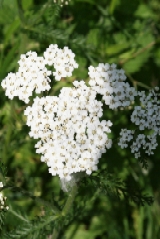|
Yarrow
Achillea millefolium
Other Names:
Milfoil, Woundwort
Distribution:
Native British wild flower which is common in hedges and on banks
throughout Britain.
Habitat:
On grassy places on most soil types and will tolerate both sun
and light shade.
Description: Rosettes
of ferny leaves at ground level with flower spikes holding flat
flower-heads consisting of lots of small white flowers.
The flowers appear from June to November and may be tinged with
pink. Its' height may be as
much as 45cms.
Uses: It has
been long used for the treatment of wounds.
It was said that the ancient Greek hero, Achilles, used yarrow to
cure wounds made by iron weapons. The Anglo Saxons believed that this
plant could purge and heal wounds when pounded with grease.
It was also used to drive away evil and sickness, especially in
Ireland
. It was
also thought to increase physical attractiveness and prevent people from
being hurt by the opposite sex.
Wildlife:
Yarrow is fed on by caterpillars of the Essex Emerald, Lime Speck
Pug, Wormwood Pug, Straw Belle and Ruby Tiger Moths.
Other Notes:
It is also a useful source of natural-looking cut flowers for use
in the home.
Sowing
Instructions for Seeds:
All year round, but March to early May or August
to September give best results. Sow seeds in a good quality
multi-purpose compost either in a greenhouse, cold frame or outside.
Germination can take from 10 days to 3 months depending on temperature.
When large enough to handle, prick out the seedlings into individual
pots. Plant out into final position from late spring onwards.
Planting in autumn will produce slightly earlier flowering than a spring
sowing.
Our
plants and seeds are of native British origin.
|
